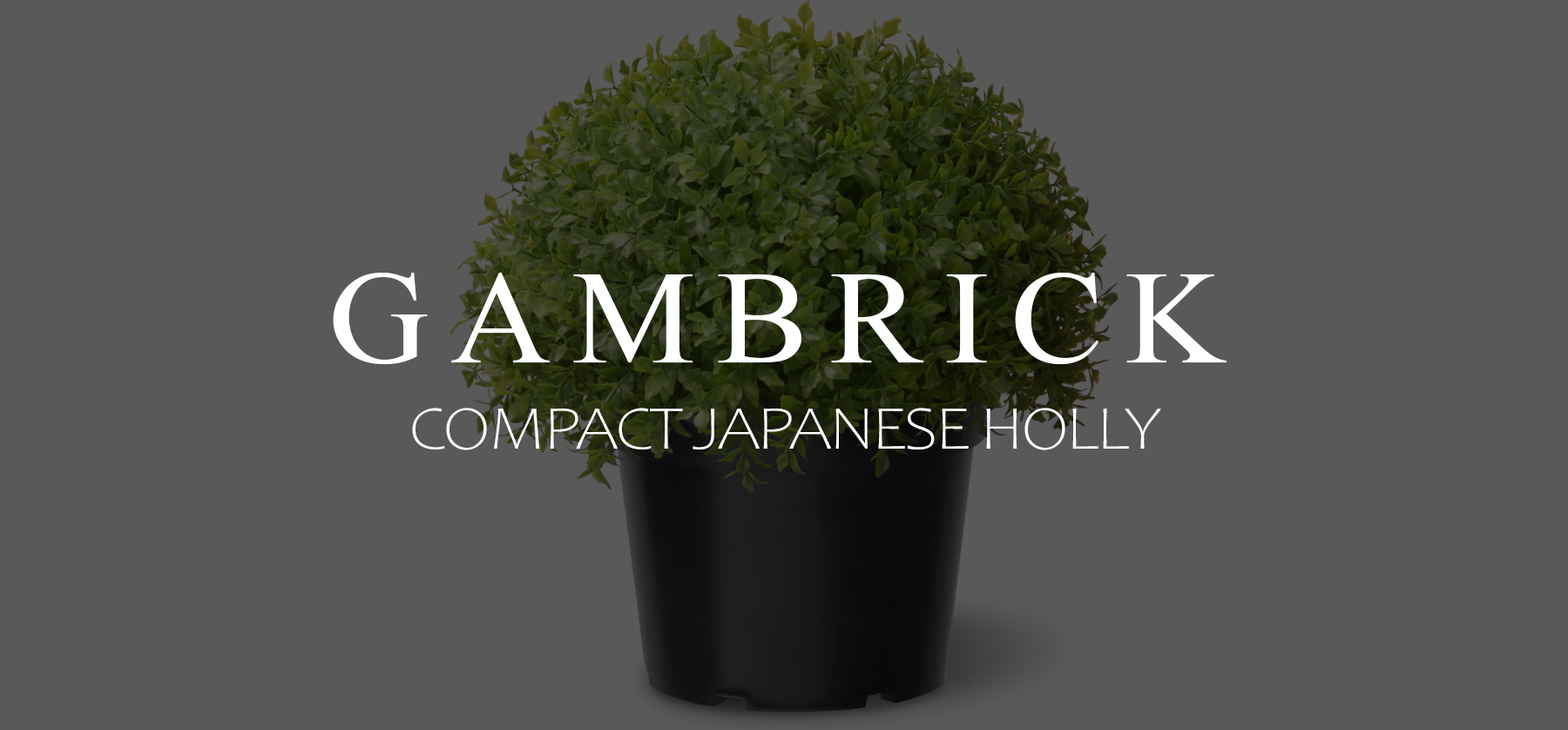Compact Japanese Holly
The Compact Japanese Holly is a beautiful evergreen shrub that’s easy to care for with very little pruning. They’re lush, full and easy to shape. Pair them with the right pot and you’ve got a classy look that’s great for a front porch, deck or around a pool. They’re great when used alone or mixed in with other shrubs, trees or flower beds. I like a minimalist design so two Compact Japanese Hollies in white pots on either side of the front door is a standard design I go to again and again. Small yellow to white flowers appear in spring which turn into black fruit in the fall. These shrubs are quite deer resistant which can be a benefit if your used to them eating your landscaping.
Compact Japanese Hollies require very little pruning but I recommend shaping them. It’s easy to do because the plant is very full. It also grows evenly so it’s easy to keep the shape. I like to prune them into a tight ball with a very simple pot. They need regular watering to establish them and during periods of extreme heat. After that they’re easier to care for. Hollies adapt to various soil types but prefer a slightly acid soil. I recommend fertilizing in early spring before new growth begins if you want more growth. Pruning generally isn’t necessary but it should be done just to maintain the shape.
- Petite deep green leaves
- Low Maintenance
- Insect and Disease resistant
- Classy in containers
- Affordable at around $25 per plant.
Ahead we’ll discuss the Compact Japanese Holly in depth. It’s one of my favorite plants at the moment and I think you should consider using them.
Where To Plant A Compact Japanese Holly
A Compact Japanese Holly likes full to partial sun so it’s important to plant them where they’ll get plenty of sunlight. I love using them on either side of the front door. We tend to build a lot of Modern and Farmhouse style homes which both look great with a few green plants. If you prune them into a ball shape they have a classy look that I really like.
I also really like them on a deck or around a pool. They can grow to six feet around but I like to keep them small and use them more as an accent.
Japanese Compact Hollies can be planted just about anywhere but they thrive in coastal areas. We’re in NJ so that’s probably why I use them so much. Here on the East Coast you see them all over. They’re a very popular plant.
They can be planted almost any time of year as long as the weather isn’t extreme. Every area has a prime growing season so plant within that time frame. I wouldn’t plant in the middle of the Winter or Summer.
I use regular garden soil that’s well drained. Stay away from soggy or overly dry soil.
You can plant Japanese Hollies right in the ground if your soil is good but I prefer to pot them. The pot is half of the look I’m going for.
How Much Water Do Japanese Hollies Need?
In general, a Compact Japanese Holly should be watered at least twice a week. However, if you live in an area that sees very hot temperatures I would water them daily.
I recommend checking the plants every day with your finger. If the soil is super dry then give them some water. But if it’s damp wait a day. I usually water mine every day in Summer and then go to twice a week in Spring, Fall and Winter.
Hollies are very hardy plants that tolerate heat, humidity, and drought really well. If your someone that has trouble keeping plants alive and healthy then give Japanese Hollies a try.
Over watering generally isn’t an issue for Japanese Hollies because they can survive in wet soils. Although I’d try to avoid it if possible.
How Big Does A Compact Japanese Holly Get?
The Compact Japanese Holly is an evergreen shrub, but unlike its 10 foot tall parent, it will only grow to 6 feet high and wide. The smaller size makes it a great choice for compact areas, as a border shrub, in pots or as an accent.
Even though the Compact Japanese Holly is smaller, they can still make a great hedge when planted with other compact hollies. If you like the hedge look but don’t have a huge amount of space give these a try.
My favorite way to plant Japanese Hollies is in a small to medium size pot. With a pot and proper pruning you can keep them in the 2-4 foot range which is just right for a porch, deck or around a pool.
Does A Compact Japanese Holly Need Pruning?
Yes and No. They don’t need much pruning, but if you want to shape them then it’s required. That really nice ball shape isn’t natural.
If you want to prune or shape your Compact Japanese Holly, you should do it in late winter or early spring. Once the shrub is shaped it doesn’t take much to maintain it. And pruning them is easy because they’re so compact. Of all the plants I’ve shaped these are one of the easiest.
If your trying to maintain a tight hedge then I’d recommend some pruning here too. You don’t want them growing wildly. Each shrub should be pruned to match the others so there’s some uniformity to the hedge. Again, this doesn’t require much maintenance. Once you achieve the look you want a once a year pruning is typically enough.
Compact Japanese Holly Care
Overall, Compact Japanese Hollies are very hardy plants that need little care.
- You should plant Japanese Hollies in light, well drained soil with plenty of organic material.
- The shrubs prefer slightly acidic soil and can develop iron deficiency if the soil pH is too high.
- You can plant them in almost any garden location since they tolerate full sun or partial shade.
- They require very little pruning and do really well in pots.
- Water them twice a week on average but every day in extreme heat.
It helps to spread a few inches of organic mulch over the planting area to hold moisture in the soil.
Japanese Hollies do best in zones 6, 7 or 8, depending on the cultivar. Cold weather can damage the foliage so you should select a cultivar that’s a little bit hardier.
Pruning is important but they don’t need much. Trim off branch tips to remove dead wood. Shape the shrubs as needed. I prefer the look of a ball shape. Compact Japanese Holly plants tolerate shearing which makes them a good choice for an evergreen hedge.
Fertilizing your Compact Japanese Holly is a good idea. It can help keep the shrub healthy and strong. Late winter to early spring is a good time to fertilize. Right before new growth starts to emerge. Another good time to fertilize is late summer.
Use a fertilizer with iron and sulfur for deep greening. Fertilize on the outside perimeter of the branch system. About 3-4 inches for a small to medium size plant, 6-8 inches for larger shrubs.
Are Compact Japanese Holly Deer Resistant?
Yes, Compact Japanese Hollies are very resistant to deer. If this is an issue for you then definitely give Japanese Hollies a try. Here in NJ we have deer everywhere and it’s hard to keep them out. They can jump right over a 6 foot high fence. They snack on just about all the other bushes and plants but they never touch the Hollies.
How Far Apart Should Compact Japanese Hollies Be Spaced?
If your trying to build a hedge with Compact Japanese Hollies, the correct spacing is about 4 feet apart. They can grow around 6 feet around so 4 feet will allow the hollies to touch but not crush each other.
In the shrub border, space plants 7 to 8 feet apart.
Compact Japanese Holly Growth Rate
A Compact Japanese Holly plant has a slow growth rate of fewer than 6 inches per year. They fully mature at around 6 feet tall and 6 feet wide if not pruned.
They can take some partial shade but will grow in full sun as well. Holly likes to be moist, but not wet so don’t over water them. Although if you do they won’t typically die. Hollies are a hardy plant. In general you should water them twice a week. In hot Summers increase watering to every day. Test the soil with your finger. If it’s dry then give them some more water.
Because Hollies don’t grow very fast, they don’t require much pruning. Once a year is generally enough. Once the shrub is shaped all it takes is a little general maintenance.
Does Compact Japanese Holly Stay Green All Year?
Yes. Compact Japanese holly is an evergreen shrub. Its glossy, broad leaves are tightly packed which creates a dense foliage that stays green all year long.
Compact Japanese Holly Statistics
| USDA Hardiness Zones: 6-9 |
| Flower Color(s): n/a |
| Bloom Period: Grown for Foliage |
| Foliage Color(s): Green |
| Light Exposure: Partial Shade to Full Sun |
| Height: 6 Feet |
| Spread: 6 Feet |
| Habit: Rounded |
| Watering: Twice a week |
| Features: Variegated Foliage |
| Scientific Name: Ilex crenata ‘Compacta’ |
| Common Name: Compact Japanese Holly |
Summary: Compact Japanese Holly
The Compact Japanese Holly is a beautiful evergreen shrub that’s easy to care for with very little pruning. They’re lush, full and easy to shape. Pair them with the right pot and you’ve got a classy look that’s great for a front porch, deck or around a pool. They’re great when used alone or mixed in with other shrubs, trees or flower beds. I like a minimalist design so two Compact Japanese Hollies in white pots on either side of the front door is a standard design I go to again and again. Small yellow to white flowers appear in spring which turn into black fruit in the fall. These shrubs are quite deer resistant which can be a benefit if your used to them eating your landscaping.
Compact Japanese Hollies require very little pruning but I recommend shaping them. It’s easy to do because the plant is very full. It also grows evenly so it’s easy to keep the shape. I like to prune them into a tight ball with a very simple pot. They need regular watering to establish them and during periods of extreme heat. After that they’re easier to care for. Hollies adapt to various soil types but prefer a slightly acid soil. I recommend fertilizing in early spring before new growth begins if you want more growth. Pruning generally isn’t necessary but it should be done just to maintain the shape.
- Petite deep green leaves
- Low Maintenance
- Insect and Disease resistant
- Classy in containers
- Affordable at around $25 per plant.
If you have any questions or comments about Compact Japanese Hollies Email any time.





















